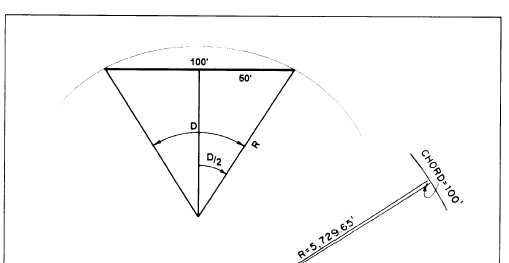By studying figure 11-4, you can see that the ratio
design speed and allowable superelevation. Then the
between the degree of curvature (D) and 360° is the
radius is calculated.
same as the ratio between 100 feet of arc and the
circumference (C) of a circle having the same radius.
That may be expressed as follows:
Since the circumference of a circle equals
above expression can be written as:
the
Solving this expression for R:
and also D:
Degree of Curve (Chord Definition)
The chord definition (fig. 11-5) is used in railway
practice and in some highway work. This definition
states that the degree of curve is the central angle
formed by two radii drawn from the center of the circle
to the ends of a chord 100 feet (or 100 meters) long.
If you take a flat curve, mark a 100-foot chord, and
determine the central angle to be 0°30’, then you have
a 30-minute curve (chord definition).
From observation of figure 11-5, you can see the
following trigonometric relationship:
Then, solving for R:
For a 1° curve, D = 1; therefore R = 5,729.58 feet, or
meters, depending upon the system of units you are
using.
For a 10 curve (chord definition), D = 1; therefore R =
In practice the design engineer usually selects the
5,729.65 feet, or meters, depending upon the system of
degree of curvature on the basis of such factors as the
units you are using.
Figure 11-5.—Degree of curve (chord definition).
11-5





